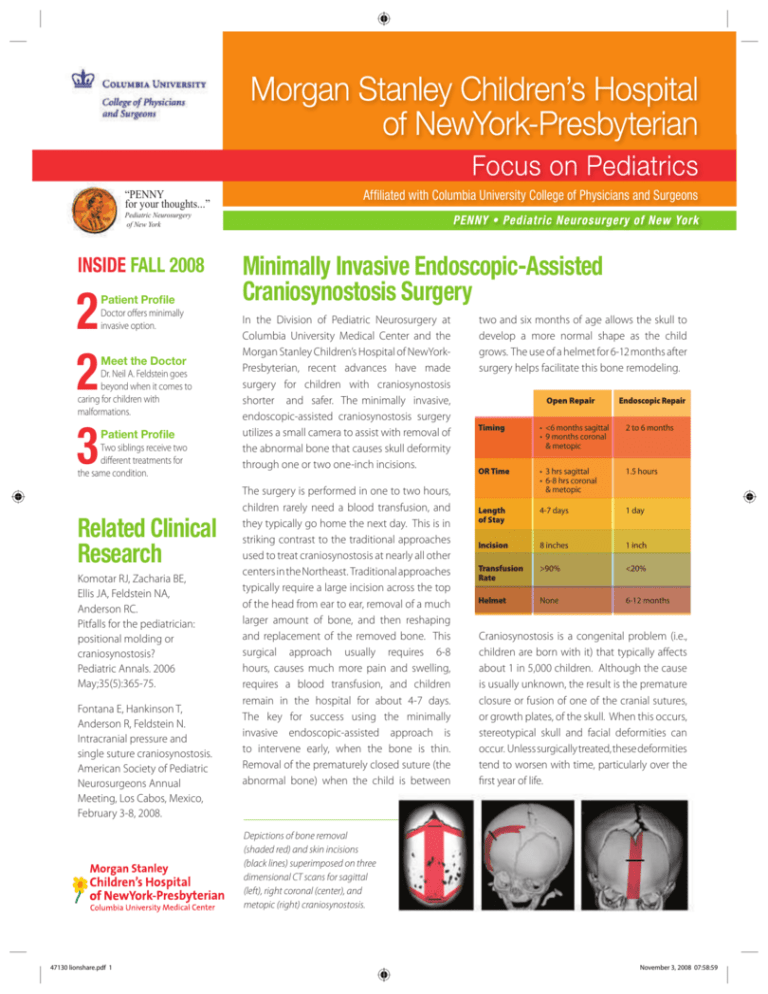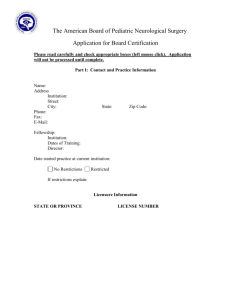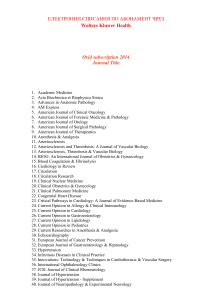Morgan Stanley Pediatric Neurosurgery Newsletter
advertisement

“PENNY for your thoughts...” Affiliated with Columbia University College of Physicians and Surgeons Pediatric Neurosurgery of New York INSIDE FALL 2008 2 2 3 Patient Profile Doctor offers minimally invasive option. Meet the Doctor Dr. Neil A. Feldstein goes beyond when it comes to caring for children with malformations. Patient Profile Two siblings receive two different treatments for the same condition. Related Clinical Research Komotar RJ, Zacharia BE, Ellis JA, Feldstein NA, Anderson RC. Pitfalls for the pediatrician: positional molding or craniosynostosis? Pediatric Annals. 2006 May;35(5):365-75. Fontana E, Hankinson T, Anderson R, Feldstein N. Intracranial pressure and single suture craniosynostosis. American Society of Pediatric Neurosurgeons Annual Meeting, Los Cabos, Mexico, February 3-8, 2008. Minimally Invasive Endoscopic-Assisted Craniosynostosis Surgery In the Division of Pediatric Neurosurgery at Columbia University Medical Center and the Morgan Stanley Children’s Hospital of NewYorkPresbyterian, recent advances have made surgery for children with craniosynostosis shorter and safer. The minimally invasive, endoscopic-assisted craniosynostosis surgery utilizes a small camera to assist with removal of the abnormal bone that causes skull deformity through one or two one-inch incisions. The surgery is performed in one to two hours, children rarely need a blood transfusion, and they typically go home the next day. This is in striking contrast to the traditional approaches used to treat craniosynostosis at nearly all other centers in the Northeast. Traditional approaches typically require a large incision across the top of the head from ear to ear, removal of a much larger amount of bone, and then reshaping and replacement of the removed bone. This surgical approach usually requires 6-8 hours, causes much more pain and swelling, requires a blood transfusion, and children remain in the hospital for about 4-7 days. The key for success using the minimally invasive endoscopic-assisted approach is to intervene early, when the bone is thin. Removal of the prematurely closed suture (the abnormal bone) when the child is between two and six months of age allows the skull to develop a more normal shape as the child grows. The use of a helmet for 6-12 months after surgery helps facilitate this bone remodeling. Open Repair Endoscopic Repair Timing $ <6 months sagittal $ 9 months coronal & metopic 2 to 6 months OR Time $ 3 hrs sagittal $ 6-8 hrs coronal & metopic 1.5 hours Length of Stay 4-7 days 1 day Incision 8 inches 1 inch Transfusion Rate >90% <20% Helmet None 6-12 months Craniosynostosis is a congenital problem (i.e., children are born with it) that typically affects about 1 in 5,000 children. Although the cause is usually unknown, the result is the premature closure or fusion of one of the cranial sutures, or growth plates, of the skull. When this occurs, stereotypical skull and facial deformities can occur. Unless surgically treated, these deformities tend to worsen with time, particularly over the first year of life. Depictions of bone removal (shaded red) and skin incisions (black lines) superimposed on three dimensional CT scans for sagittal (left), right coronal (center), and metopic (right) craniosynostosis. 47130 lionshare.pdf 1 November 3, 2008 07:58:59 Patient Profile William C. Doctor Offers Alternative Option The day after he was born on April 3rd, 2008, William C. was diagnosed with craniosynostosis—a premature closure of the cranial sutures. This condition is known to cause problems with brain and skull growth, and skull deformity. To correct the condition, William’s parents met with two neurosurgeons. The two doctors recommended cranial vault remodeling, a procedure that involves making a large incision across the top of the infant’s head, removing a large amount of bone, reshaping the bone, and then replacing it. It’s an extensive procedure that would cause two week-old William to remain in the hospital for 4-7 days after the surgery and seemed rather traumatic. This upset the family, and they sought out a third doctor. mentioned the procedure, it was in a negative light. They also tried to convince the family it was uncommon and dangerous. Still, they were sure that this route was the right path to follow and they opted to go with Dr. Anderson and his recommended procedure. After the surgery, William didn’t even look like anything had been done to him. He didn’t appear to have any pain, and his small incisions healed rather quickly. Now, less than four months later, William is doing quite well. The family felt extremely comfortable with their decision: “Everything that Dr. Anderson said would happen—from surgery to recovery—happened,” they said. “We are very grateful, and would recommend him to anyone.” When they met with Dr. Anderson, they expected to receive the same recommendation the first two doctors had given. But much to their delight, he suggested a minimally invasive endoscopic procedure that would allow William to go home the very next day. It was a procedure that could be done at William’s young age. Even though the other two doctors briefly Dr. Neil A. Feldstein Meet the Physician Dr. Neil A. Feldstein has been the director of the Division of Pediatric Neurological Surgery since his arrival in 1994. He received his undergraduate training at the University of Rochester where he majored in sociology. Dr. Feldstein later studied medicine at New York University School of Medicine where he earned his MD degree. Returning to his roots, he then continued with internship and formal residency training in neurological surgery at Baylor 2 47130 lionshare.pdf 2 November 3, 2008 07:59:00 Patient Profile Kiran & Leela R. Siblings Receive Different Procedures For Same Condition to remove the abnormal bone which left him with only three tiny incisions. Kiran went home the next morning with minimal swelling. Kiran wore a helmet for 23 hours a day for 10 months, and is now otherwise a normal and healthy child. Brother and sister were born with the same condition. They were treated by the same doctor, but received different procedures. One went home in five days. The other went home the next day. Leela R. was born with craniosynostosis— a premature closure of the cranial sutures. Six months later, she had cranial vault reconstruction surgery. This was a one-time fix and her condition was corrected. However, the cranial vault remodeling procedure was very traumatic because it was long and risky, involving a large portion of her forehead and skull. It demanded a long recovery time, including five nights in the hospital, and resulted in longterm swelling. It also resulted in a large scar from ear to ear. The family was thrilled with each outcome, but without hesitation would recommend the endoscopic procedure, mostly because it could be performed more immediately instead of having to wait until the baby is six months old, and the procedure and recovery time was so much faster than the cranial vault reconstruction surgery. Dr. Feldstein was the doctor of choice for both surgeries. “He was wonderful,” the family said. “He outlined the options clearly and provided us with the information we needed in order to make an informed decision. He was very patient and thorough, and guided us through each process with such great attention to detail as well as our thoughts and feelings.” Leela’s brother, Kiran, was born a few years later with the same condition. Expecting a similar discussion regarding surgical options, the family was excited to learn about the development of a new minimally-invasive approach offered. At two months old, he had a minimally-invasive endoscopic assisted procedure College of Medicine in Houston, Texas. Deciding on a career in pediatric neurological surgery, Dr. Feldstein then returned to New York University School of Medicine for an additional year of fellowship training in pediatric neurological surgery. After a several year stint in New Jersey at the University of Medicine and Dentistry of New Jersey, he was recruited to join the faculty at Columbia University and the Morgan Stanley Children’s Hospital of NewYork-Presbyterian. spinal dysraphism, brain and spinal cord tumors, craniofacial abnormalities, and vascular malformations such as Moyamoya, AVMs, and cavernous malformations. His research efforts are largely focused on the management of children with Chiari I malformations and the relationship between Chiari I and autism. In addition, Dr. Feldstein has an active interest in international efforts, and has led medical missions to Guatemala for the surgical care of children born with spinal bifida and hydrocephalus. Under his leadership over the last 14 years, the division has grown to include three board certified, full-time pediatric neurological surgeons who cover all aspects of pediatric neurological surgery. Dr. Feldstein’s clinical interests include Chiari malformations, In his free time, Dr. Feldstein enjoys spending time with his wife and two children, as well as being an avid runner, graphic artist, and woodworker. 3 47130 lionshare.pdf 3 November 3, 2008 07:59:01 /FJM"'FMETUFJO.%'"$4ttOBG!DPMVNCJBFEV The Division of Pediatric Neurosurgery at Columbia University Medical Center and the Morgan Stanley Children’s Hospital of NewYork-Presbyterian, one of the largest in the Northeast, offers comprehensive services for all children with neurosurgical issues. With three full-time board certified pediatric neurosurgeons practicing at the highest ranked Children’s Hospital in the Tri-state area, the Division provides a broad range of expertise in an unparalleled, supportive environment. Clinical problems including hydrocephalus, brain and spinal tumors, Chiari malformation, craniosynostosis, tethered cord, complex spinal deformity, spasticity, epilepsy, arteriovenous malformations (AVMs), Moyamoya, and many other disorders are treated with the most effective methods available. Patients can be seen at nine convenient locations throughout the Tri-state area. For an appointment with one of our pediatric neurosurgeons, call any of the numbers listed on this page. .BOIBUUBO – The Neurological Institute, 710 W. 168th St., Room 213, New York, NY 10032 New Jersey – 1200 East Ridgewood Ave., Suite 200, Ridgewood, NJ 07450 – 85 Raritan Ave., Highland Park, NJ 08904 4BBEJ(IBUBO.%'"$4ttTH!DPMVNCJBFEV .BOIBUUBO – The Neurological Institute, 710 W. 168th St., Room 213, New York, NY 10032 – 16 East 60th St., Suite 450, New York, NY 10022 – 1000 Tenth Ave., New York, NY 10019 – 10 Union Square East, Suite 5J, New York, NY 10003 3JDIBSE$&"OEFSTPO.%'"$4'""1ttSDB!DPMVNCJBFEV .BOIBUUBO – The Neurological Institute, 710 W. 168th St., Room 213, New York, NY 10032 New Jersey – 1200 East Ridgewood Ave., Suite 200, Ridgewood, NJ 07450 – 703 Main Street, Room A2404, Paterson, NJ 07503 $POOFDUJDVU – 32 Strawberry Hill Court, 4th Floor, Suite 7, Stamford, CT 06905 Visit our website at childrensnyp.org/mschony or www.columbianeurosurgery.org See inside for the latest in Pediatric Neurosurgery NewYork-Presbyterian Hospital Columbia University Medical Center Department of Neurological Surgery 710 West 168th Street, Room 213 New York, NY 10032 LIONSHARE PAID NON PROFIT ORG U.S. POSTAGE 47130 lionshare.pdf 4 November 3, 2008 07:59:01





